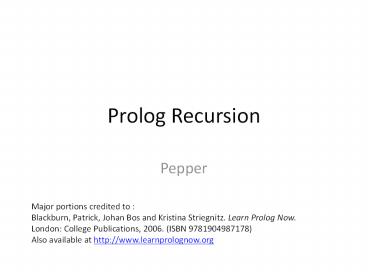Prolog Recursion - PowerPoint PPT Presentation
Title:
Prolog Recursion
Description:
Prolog Recursion Pepper ... (a, b, go(b, e)) ; X = go(a, b, go(b, d, go(d, e))) ; Adding Numbers adder(X, Y, Z):- Z is X + Y. 10 ?- adder(1,2,X). X = 3. – PowerPoint PPT presentation
Number of Views:110
Avg rating:3.0/5.0
Title: Prolog Recursion
1
Prolog Recursion
- Pepper
Major portions credited to Blackburn, Patrick,
Johan Bos and Kristina Striegnitz. Learn Prolog
Now. London College Publications, 2006. (ISBN
9781904987178) Also available at
http//www.learnprolognow.org
2
A rule with that calls itself
- is_digesting(X,Y) - just_ate(X,Y).
- is_digesting(X,Y) -
- just_ate(X,Z),
- is_digesting(Z,Y).
- 2 rules
- You are digesting what you just ate
- You are digesting whatever you ate just ate
- And so on until you come to an animal that did
not just eat something.
3
Use in a query
- just_ate(mosquito,blood(john)).
- just_ate(frog,mosquito).
- just_ate(stork,frog).
- just_ate(person,cow).
- just_ate(cow,frog).
- is_digesting(person,X)"?
- Please answer 'y' or 'n'? yes
- X cow
- X frog
- X mosquito
- X blood(john)
4
Construction
- is_digesting(X,Y) - just_ate(X,Y).
- is_digesting(X,Y) -
- just_ate(X,Z),
- is_digesting(Z,Y).
- Base case
- Does not use its own predicate.
- Recursive rule
- Handles one case,
- Recurses over the rest of the cases.
5
Proof
- Is_digesting(person,A).
- What just_ate fact has person on the left side,
then the right side can be X. look for
just_ate(person,A). - Look for just_ate(X,Z), is_digesting(Z,Y).
- if just_ate (person,_1) and (_1, A)
- so (person,cow) and (cow,frog) match
- so A frog
6
Recursion of descendants
- facts
- child(anne,bridget). child(bridget,caroline
). child(caroline,donna).
child(donna,emily). - Find descendants - not far enough
- descend(X,Y) - child(X,Y).
descend(X,Y) - child(X,Z),
child(Z,Y).
7
Recursion Analysis
- Base case
- Does not use its own predicate.
- If y is a child of x, y descends from x
- descend(X,Y) - child(X,Y).
- Recursive rule
- Handles one case,
- Recurses over the rest of the cases.
- If y is a child of a descendant of x, then y is a
descendant of x - descend(X,Y) - child (I,Y), descend(X,I)
8
Exercise graph
- Connected points
- edge(a,b).
- edge(b, c).
- edge(b, d).
- edge(b, e).
- edge(d, e).
- edge(y,x).
- edge(x,z).
- What points can you reach from a particular
point? Assumes no circular connections. - connected(a,X).
- connected (X, z).
9
Accumulate text
- Without Accumulation
- descend(X,Y) - child(X,Y).
- descend(X,Y) - child (I,Y), descend(X,I)
- With Accumulation
- descend(X,Y, childrel(X,Y))- child(X,Y).
- descend(X,Y,childrel(X,I,L))- child(X,I),
- descend(I,Y,L).
- Query
- descend2(anne,donna,X).
- X parentChild(anne, bridget, parentChild(bridget
, caroline, parentChild(caroline, donna)))
10
Exercise Walk the Graph
- Given a list of edges
- Show the path that connects from one edge to
another - connectedPath(a,e,X).
- Should give
- X go(a, b, go(b, e))
- X go(a, b, go(b, d, go(d, e)))
11
Adding Numbers
- adder(X, Y, Z)- Z is X Y.
- 10 ?- adder(1,2,X).
- X 3.
- 11 ?- adder(X,2,3).
- ERROR is/2 Arguments are not sufficiently
instantiated
12
Random Numbers
- random/3 given a range of numbers as the first
2 arguments, a random number starting from the
first number but not including the last number.
(for dice 1, 7) - makeroll(X) - random(1,7,X).
- adder(X,Y,Z)- Z is X Y.
- throw2(Z) -
- makeroll( X), makeroll( Y), Z is X Y.
- You can add writeln(Z).
13
Count Recursive Attempts
- Need one variable to initialize to 0 when you
start. - When you recurse, add 1 to the variable you
initialized to 0 - When you are done, add 1 to the accumulated list.
- ExamplethrowUntil_11(Count, FinalCount)-
- FinalCount is Count 1, throw2(11).
- throwUntil_11(Count, FinalCount)-
- throw2(Y), Z is Count 1, Y \ 11
- throwUntil_11(Z, FinalCount).
- Example query throwUntil_11(0,X).
14
Exercise Count Edge Walk Recursions
- Count the number of possible steps between two
points. - countConnections(a,e,0,X).
- X 2
- X 3
15
Recursion Summary
- How to declare a recursive rule
- How to pair the recursive rule with a base case
- How prolog proof leads to recursion
- No base case endless recursion
- Random
- Counting recursive steps































